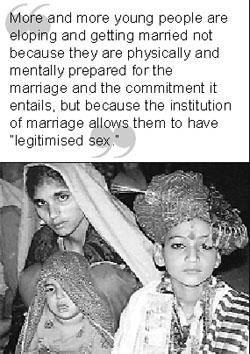 Menu
Menu
By making consensual sex illegal between the age of 16 and 18, the proposed bill in the Rajya Sabha will empower moral policing and will encourage illegal abortions — putting the lives of teenage girls at risk
Bharti Ali
THE much talked about ‘age of consent’ refers to the age at which a person’s consent to have sex is recognised as valid in the eyes of the law. Engaging in sexual activity with persons below this age is a criminal offence irrespective of the consent of such person. However, determining the age of consent has always been a complex exercise.
A historical perspective
 Laws on the subject have been dominated by patriarchal values that have insisted on the “purity” of women and have always sought control over women’s sexuality. Since sexual activity before or outside marriage has always been a taboo for women, it is the “age of marriage” that, by and large, decided the minimum age for sexual consent in most countries. Even today, almost all Islamic countries have kept the age of consent as the age of marriage.
Laws on the subject have been dominated by patriarchal values that have insisted on the “purity” of women and have always sought control over women’s sexuality. Since sexual activity before or outside marriage has always been a taboo for women, it is the “age of marriage” that, by and large, decided the minimum age for sexual consent in most countries. Even today, almost all Islamic countries have kept the age of consent as the age of marriage.
In India, it was during the British rule that the debates on child marriage resulted in the Age of Consent Act, 1891. This Act raised the said age for girls from 10 years to 12. Subsequently, the 1983 amendments in the rape law, as contained in the Indian Penal Code (IPC), made it 16 years for all girls (barring a few states where it remained at 14).
As attitudes towards sexuality and childhood changed during the latter part of the 19th century and the beginning of the 20th century, the age of consent too changed. Globally, the average age of consent today is 16 years (with variations) and there are several factors which are taken into consideration while determining the same.
Why at 18?
 About 40 percent of the world’s child marriages take place in India. Under the proposed law, what will be their status? |
The most common argument extended to back the age of sexual consent as 18 years is that “body does not mature to have sex at a young age”. For the HIV/AIDS lobby, the mantra has been that governments can, to some extent, reduce the risk of HIV infection among young by raising the age of consent for sex, and also marriage.
The child rights sector has lobbied for higher age of consent in order to ensure protection of all children from abuse and exploitation. Following its commitment to protection of child rights, Government of India’s concentration in the process of drafting the “Protection of Children against Sexual Offences Bill” has been on the changes required in the existing law to deal with child sexual abuse in all its forms and in various settings. In the course of preparation of the said bill, the National Commission for Protection of Child Rights (NCPCR), the apex body too had put together a draft.
With respect to the age of consent, the Ministry of Women and Child Development (WCD) in its original draft relied on the Indian Penal Code to keep it at 16 years. Being gender neutral, the bill kept the same age of consent for girls and boys. But in the case of children aged 16-18 years it laid down conditions that would determine whether the sexual act was consensual. These conditions applied to offences clubbed as “sexual assault” (defined in the Bill as penetrative acts or acts involving insertion of objects other than penis in a child’s vagina, urethra or anus).
The provisions relating to “sexual harassment” (defined in the Bill as gesturing with sexual intent, forcing a child to exhibit its body or threatening to use any form of media to depict a child in a sexual act) did not contain anything with respect to the age of consent.
The NCPCR draft had also kept the age of consent at 16 for penetrative sexual offences against children by adults but decriminalised consensual non-penetrative sexual activity between children of certain ages.
For example, consensual non-penetrative sexual act between children over 12 years of age or whose age difference is within two years of each other was not to be an offence. The NCPCR Bill created much confusion as the civil society had no access to the draft and on the other hand media reporting suggested that the age of consent for certain sexual activity was being lowered to 12.
Legislation and sexuality
The Bill in its present form has incorporated changes recommended by the Parliamentary Committee including raising the age of consent to 18. Despite strong advocacy for keeping it at 16 and decriminalising consensual sex between 16-18 year olds, the Parliamentary Committee suggested a higher age on the grounds that once a child is defined as a person below the age of 18 years, the element of consent should be treated as irrelevant up to this age.
Another question is, can a criminal legislation deter young people from engaging in sexual activity? The answer is a clear ‘NO’ as is evident from the present crime statistics.
Between 2005 and 2010 there has been a 256.25 percent increase in kidnapping and abduction of girls aged 15-18 years for the purpose of marriage. The 2010 Crime in India Report of the National Crime Records Bureau states that “Marriage” was the main cause of kidnapping and abduction of females accounting for 46.9 percent (18,354 out of 39,148) of the total females kidnapped and abducted in 2010.
At the same time, there is a 43.98 percent increase between 2005 and 2009 in cases of kidnapping and abduction of women and girls. More than 1,000 young people in India have been done to death every year owing to “honour killings” linked to marriage. It is widely acknowledged that majority of the children reported missing leave their homes on their own will for a variety of reasons ranging from elopement to fear of parents. The magnitude is in fact greater than what meets the eye.
Since morally we continue to wish and impose the “legal age of marriage” to be the “age of sexual consent”, we keep our children away from receiving critical information and education on sexuality and responsible sexual behaviour. Can we really afford to ignore that sexual exploration and activity start in a child’s life much before entering into a marital relationship?
In fact, more and more young people are eloping and getting married not because they are physically and mentally prepared for the marriage and the commitment it entails, but because the institution of marriage allows them to have “legitimised sex”.
Interestingly, while the Prohibition of Child Marriage Act prohibits marriage below the age of 18 years for girls and 21 years for boys, it does not make a child marriage invalid or null and void unless either of the parties seeks an annulment. But today, while raising the age of sexual consent to 18 the legislators have clearly allowed sexual relationship between an underage wife and husband to be booked for a criminal act of sexual abuse. An otherwise legally married man can thus be spending his hay days in detention if this Law was to get through the Parliament of India. Even if the child marriage law is amended in future to automatically nullify a child marriage, young people will continue to enter into pre-marital sexual relationships. How will we then protect them?
Young will be young
A 2010 Policy brief prepared by the Indian Institute of Population Studies on the basis of a study of youth in India shows that amongst those who reported pre-marital romantic partnership, 88 percent men and 74 percent women held hands with their romantic partner, more than two-thirds (68-71 percent) men and almost half (46-19 percent) women had hugged or kissed their romantic partner, and more than two-fifths men (42 percent) and one-quarter women (26 percent) had engaged in sex with their romantic partner.
In most liberalised democracies what has come to be the “formula” for deciding on the age of consent is to first consider the “basic age of consent” set out in a country (which may be based on notions of childhood, age of marriage and social norms), then add to it the rules governing sexual activity with an under-age person in certain special circumstances such as in a relationship of trust or authority, the age under which children must be protected against adult manoeuvres and exploitation and finally subtract the exceptions such as sexual activity between two minors in the same age group or within the age difference of two to three years, sexual activity due to a misunderstanding with respect to the age of the person etc.
Clearly, India has kept itself away from this “formula” while drafting the said Bill and hence many young people in consenting relationships would have to face the brunt of it and so would the state exchequer for keeping them in detention and conducting judicial proceedings.
In the end game, a law conceived to do good to children would end up doing them avoidable harm.
|
TEEN SEX STORY IN THE DEVELOPED WORLD
Canada
The USA
The UK |
(The writer is Founder and Co-Director HAQ: Centre for Child Rights, New Delhi)
http://www.tribuneindia.com/2012/20120521/edit.htm#6